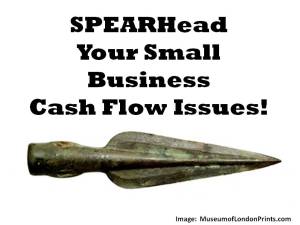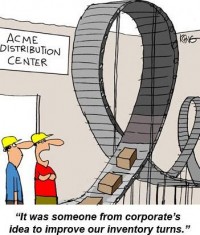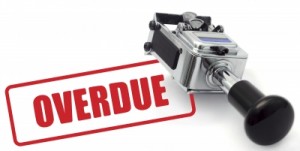The beginning of the year is often exciting in business as new goals are set for the year, which leads the entrepreneur to have new excitement and energy for their business. Goal setting in business happens in many different ways, either formally via writing a business plan, writing a set of bullet points listing goals, or ‘head based’ desires on the part of the owner to have a more successful business in 2014.
This article is not about goal setting, rather it is about helping you to substantially grow your business profits by focusing on what is occurring within your business at present. So, let’s get started.
I believe there are 10 key areas of business that an entrepreneur should be looking at to aid in the financial success of their business. What are they?
Cash Flow Management – I have a saying in business: Turnover is vanity, Profit is sanity, Cash flow is reality. Many small businesses do not have strong systems in place to collect outstanding invoices from customers after the work has been done. What systems have you implemented in your business to ensure you get paid by your customers in a timely way? Also, do you fully embrace active cash management across your business by managing your accounts payable and negotiating payment terms with your suppliers? How about inventory turns? Do you actively control the amount of inventory you hold at any one time? Poor cash management leads to the deterioration of the business, and at times, failure.
Monthly Financial Management – Do you know the costs of running your business each month relative to the turnover you are generating? Many small businesses have a ‘cash in/cash out’, receipts and payments mentality when running their business. They do not have monthly management accounts to help them manage their business. Year end accounts are only useful to determine the profitability of your business and how much tax is to be paid. They will not help you to manage your business during the year. So, how about getting your accountant to work with you throughout the year, producing monthly management accounts that you can analyse together? Monthly analysis will enable you to make improvements in your business during the year to enhance your business’s profitability.
Product and Service Profitability – Another element of financial management is understanding the profitability of all the products and services you offer to your customers. The most expensive product or service you sell to your customers may not be the most profitable to your business. How about learning about product and service profitability, working out which are your most profitable, and selling more of those to your customers. That strategy alone will have a measureable impact on your business’s profitability.
Customer Profitability – Do you know who your most profitable customers are? Most business owners do not. Many businesses aim to service any customers that come their way without thinking about whether they are going to be profitable customers. So, learning how to work out customer profitability is critical to making more profit in your business.
Differentiating your Product and Service Offering – Do you sell all your products and services as one offering or do you differentiate them according to what your customers need and can afford? Do you make offers to your customers to cross-sell, up-sell, down-sell and frequently sell your products and services? Those businesses that have a strategy in place to differentiate their product and service offerings are making BIG profits.
Pricing – How about increasing your prices to your customers? This is a touchy subject as many business owners think that they will not survive if they increase their prices. Studies have shown that only 9 percent of customers move away from a supplier due to price increases, yet 82 percent will move away to a new supplier due to perceived indifference and unresolved conflict with the original supplier. It comes down to value. How much value do you think you are offering your customers for the prices you charge, and do they feel that they are really important to your business?
More Customers – All businesses want to grow their customer base, but many small businesses do not have a strategy in place to attract new customers? How are you marketing your business? How much networking are you doing? Most markets are crowded, so how are you standing apart from your competitors, so that when a potential customer hears of you, they will come to your business for the product or service you are offering? Get this right and you will have a constant funnel of customers coming your way.
Systemising Your Business – Regardless of whether your business is just you, or you plus your employees, is your business systemised and automated in a way that your customers receive streamlined service? If not, then you are offering what I refer to as ‘random service’, which is unpredictable and not able to be replicated by your staff. McDonald’s doesn’t make the best hamburgers in the world, but they developed arguably the best systems in the world to deliver their products to their customers. How does your business measure up? If your customers return more than once to buy from you, will they get a consistent experience with your business? If not, then your business is not systemised.
Lifelong Learning – I am a ‘lover of lifetime learning’. Are you? There is so much to learn about business and it is easily accessible and often free via the internet and networking, so there is really no excuse for any business owner not to continue learning. I believe we can never learn enough, and that there is always something to learn. How about embracing the idea and developing more knowledge in business to support your success? Time and time again we hear from the world’s most successful entrepreneurs, and on every occasion they say that embracing ongoing learning was key to their success.
Mindset – Do you truly believe that you will be successful in business, and that you will topple any hurdle that gets in your way? If you do, then you will be hugely successful in your business. If not, then how about spending time evolving your mindset towards believing that you can achieve anything you want in business and life? Once the belief is set, you will be invincible. I just love the quote: “The future belongs to those who believe in the beauty of their dreams”. ~ Eleanor Roosevelt.
So, that’s it. My top 10 strategies to help you make Big Profits in your business in 2014. I hope you embrace the strategies to support your HUGE business success.
If you would like to learn more about finding more profitable customers for your business, please download any of the FREE resources that may be helpful to you at www.adelemclay.com/free-resources
Could some guidance from me be helpful to you? If so, please arrange a free 30 mins Skype strategy meeting with me. Here’s my calendar to book a meeting. I’d love to support you in some way to gain ‘seductive clarity’ in any aspect of your business or life.









